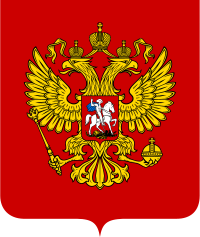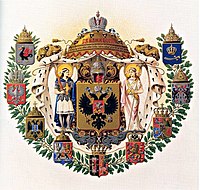Coat of arms of the Russian Empire
| Coat of arms of Russia | |
|---|---|
 |
|
| Versions | |

Emblem of the Russian Federation without the red shield.
|
|
| Details | |
| Armiger | Russian Federation |
| Adopted | 30 November 1993 |
| Escutcheon |
Gules, a double-headed Imperial Eagle displayed, twice imperially crowned, grasping in the dexter claw an imperial sceptre, and in the sinister claw an imperial orb, all Or. In chief another larger imperial crown with issuant and pendent therefrom a ribbon of the Order of St. Andrew the First-Called, also Or. The Imperial Eagle is charged on the breast with an escutcheon: Gules, an image of St. George Martyr the Victorious in complete armour Argent, wearing a flying cloak Azure, riding a horse in full gallop Argent; the latter treading upon a dragon crawling in base Or, whose head the rider is piercing through with a spear Argent. |
| Coat of arms of the Russian Empire | |
|---|---|

Greater version
|
|
| Versions | |

Middle version
|
|

Lesser version
|
|
| Details | |
| Armiger | Emperor of Russia |
| Lesser coat of arms of the Russian Empire | |
|---|---|
 |
|
| Details | |
| Armiger | Emperor of Russia |
| State Emblem of the Russian SFSR State Emblem of the Soviet Union |
|
|---|---|
 |
|
| Versions | |

Emblem of the Soviet Union
|
|
| Details | |
| Armiger |
Russian Soviet Federative Socialist Republic Union of Soviet Socialist Republics |
| Adopted | 10 July 1918 6 July 1923 |
| Crest | Red five-pointed star with golden border |
| Escutcheon |
RSFSR: The acronym "PCФCP" as well as the hammer and sickle upon a rising sun USSR: Hammer and sickle, globe and the rising sun. An emblem is surrounded by ears of wheat wrapped around a red ribbon with the state motto in all 15 languages of the Soviet Union. |
| Supporters | Stalks of wheat |
| Motto | Workers of the world, unite! |
| Other elements | red star |
Gules, a double-headed Imperial Eagle displayed, twice imperially crowned, grasping in the dexter claw an imperial sceptre, and in the sinister claw an imperial orb, all Or. In chief another larger imperial crown with issuant and pendent therefrom a ribbon of the Order of St. Andrew the First-Called, also Or.
The coat of arms of the Russian Federation derives from the earlier coat of arms of the Russian Empire which was abolished with the Russian Revolution in 1917 and restored in 1993 after the constitutional crisis. Though modified more than once since the reign of Ivan III (1462–1505), the current coat of arms is directly derived from its mediaeval original, with the double-headed eagle having Byzantine and earlier antecedents from long before the emergence of any Russian state. The general tincture corresponds to the early fifteenth-century standard. The shape of the eagle can be traced back to the reign of Peter the Great (1682–1725), although the eagle charge on the present coat of arms is golden rather than the traditional, imperial black.
The two main elements of Russian state symbols (the two-headed eagle and the mounted figure slaying the dragon) predate Peter the Great. Today, however, the official description does not refer to the rider on the central shield as representing Saint George, mainly in order to maintain the secular character of the modern Russian state. However, the Bank of Russia's website reads:
На аверсе монеты изображены: в центре — рельефное изображение Георгия Победоносца верхом на коне, поражающего копьем змея;
which is translated, on the website, to:
"The obverse: in the center — the relief image of Saint George the Warrior on horseback killing a serpent with a spear;"
in the website's description of the obverse, or the front side, of Russia's currently circulating one, five, ten, and fifty kopeck coins.
The current coat of arms was designed by artist Yevgeny Ukhnalyov; it was adopted officially on November 30, 1993 [1]. Today, the imperial crowns on each head stand for the unity and sovereignty of Russia, both as a whole and in its constituent republics and regions. The orb and scepter grasped in the eagle's talons are traditional heraldic symbols of sovereign power and authority. They have been retained in the modern Russian arms despite the fact that the Russian Federation is not a monarchy, which led to objections by the Communists even though both the blue ribbon and the collar of the Order of St. Andrew (which in the imperial arms supported the three crowns and surrounded the central shield) have been removed from the current coat of arms.
...
Wikipedia
